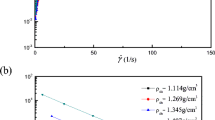Abstract
In this paper, a three-dimensional isopycnal approach is presented to simulate the dynamics of fluid mud covering the formation, development, transport, and disappearance of fluid mud. The basic assumption is the assignment of the fluid’s density as the indicating parameter for the rheological behavior. Considering stable stratification, as is usually the case for fluid mud, layers of constant density discretize the vertical domain. The non-Newtonian dynamics of fluid mud is simulated by solving the Cauchy equations for general continuum dynamics. Instead of using a turbulent viscosity approach, the viscosity is allowed to vary according to the rheological behavior of mud suspensions. This apparent viscosity can be determined for different rheological formulations in dependence of the volume solid fraction and the shear rate. An existing three-dimensional isopycnal hydrodynamic model was extended for vertical mass transport processes and was applied on a schematic system with hindered settling. For including the rheological behavior of fluid mud, the Worrall–Tuliani approach was parameterized and implemented. The resulting flow behavior is shown on a model application of fluid mud layers moving down an inclined plane. With these changes, it is demonstrated that the isopycnal model is capable of simulating fluid mud dynamics.












Similar content being viewed by others
References
Casulli V (1997) Numerical simulation of three-dimensional free surface flow in isopycnal co-ordinates. Int J Numer Methods Fluids 25:645–658
Casulli V, Walters RA (2000) An unstructured three-dimensional model based on the shallow water equations. Int J Numer Methods Fluids 32:331–348
Cheng DC-H (1985) Yield stress: a time-dependent property and how to measure it. Rheol Acta 25:542–554
Crapper M, Ali KHM (1997) A laboratory study of cohesive sediment transport. In: Burt N, Parker R, Watts J (eds) Cohesive sediments. Wiley, London, pp 197–211
Dankers PJT (2006) On the hindered settling of suspensions of mud and mud–sand mixtures. PhD thesis, Delft University of Technology, Gildeprint, the Netherlands
Herschel WH, Bulkley R (1926) Konsistenzmessungen von Gummi-Benzollösungen. Colloid Polym Sci 39(4):291–300
Lamb H (1932) Hydrodynamics, 6th edn. Cambridge University Press, New York
Malcherek A, LeNormant C, Peltier E, Teisson C, Markofsky M, Zielke W (1994) Three dimensional modeling of estuarine sediment transport. Proceedings of Estuarine and Coastal Modeling III, ASCE, New York
Migniot C (1968) Étude des propriétés physiques de différentes sédiments très fins et de leur comportement sous des actions hydrodynamiques. Houille Blanche 7:591–620
Moore F (1959) The rheology of ceramic slips and bodies. Trans Brit Ceramic Soc 58(7/8):470–494
Nasner H (2009) Eigenschaften und Verhalten von fluid mud in Brackwasserhäfen, Schlussbereicht, 03KIS051. Hochschule Bremen–University of Applied Sciences, Institut für Wasserbau
Pond S, Pickard G (1983) Introductory dynamical oceanography, 2nd edn. Pergamon, Oxford
Toorman EA (1999) Sedimentation and self-weight consolidation: constitutive equations and numerical modelling. Geotechnique 49(6):709–726
Whitehouse R, Soulsby R, Roberts W, Mitchener H (2000) Dynamics of estuarine muds. Thomas Telford, Wallingford
Winterwerp JC, Wang ZB, van Kester JATM, Verweij JF (2002) Far-field impact of water injection dredging in the Crouch River. Proceedings of the Institution of Civil Engineers Water & Maritime Engineering 154(4):285–296
Winterwerp JC, Kesteren WGM (2004) Introduction to the physics of cohesive sediment in the marine environment. Developments in Sedimentology, 56. Elsevier, Amsterdam
Worrall WE, Tuliani S (1964) Viscosity changes during the ageing of clay–water suspensions. Trans Br Ceram Soc 63:167–185
Acknowledgment
The work presented in this paper is made possible by the project MudSim funded by the German Coastal Engineering Research Council (KFKI) in the German Ministry for Research and Education (BMBF) under contract nos. 03KIS066 and 03KIS67. The authors gratefully acknowledge V. Casulli for helpful discussions and for providing a hydrodynamic numerical code for further developments to simulate fluid mud dynamics.
Author information
Authors and Affiliations
Corresponding author
Additional information
Responsible Editor: Ashish Mehta
Rights and permissions
About this article
Cite this article
Knoch, D., Malcherek, A. A numerical model for simulation of fluid mud with different rheological behaviors. Ocean Dynamics 61, 245–256 (2011). https://doi.org/10.1007/s10236-010-0327-x
Received:
Accepted:
Published:
Issue Date:
DOI: https://doi.org/10.1007/s10236-010-0327-x



